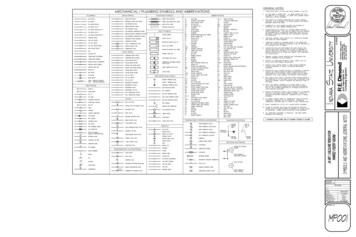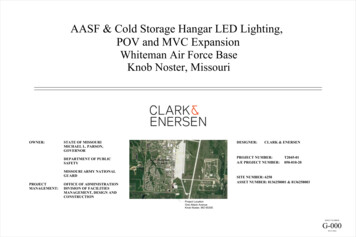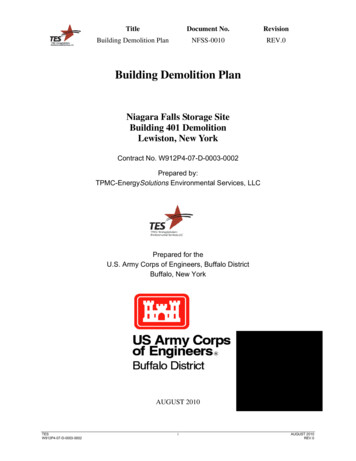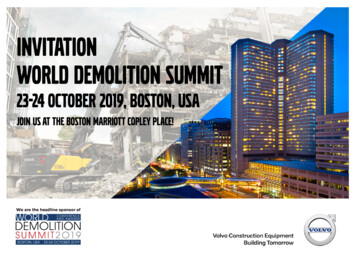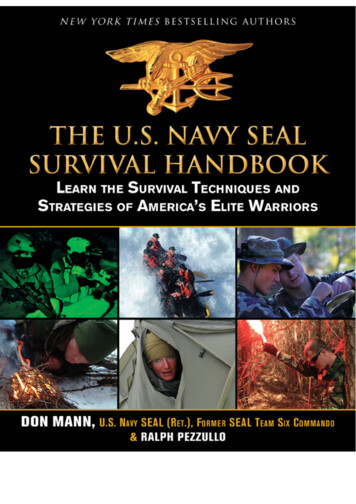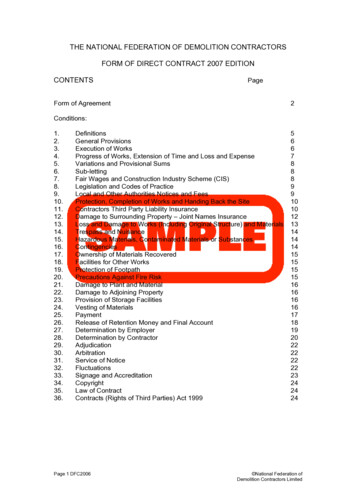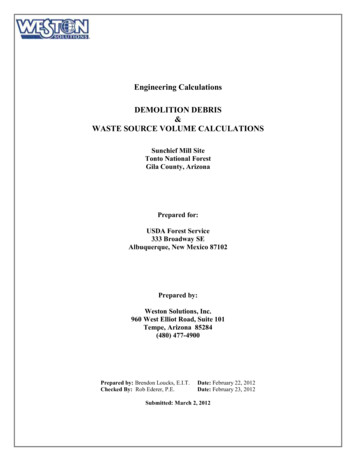
Transcription
WorkSafe BC Guidelines Regarding Demolition andAsbestos Waste MaterialsG20.112 Hazardous Materials - AsbestosIssued June 18, 2008; Revised consequential to February 1, 2012 Regulatory AmendmentRegulatory ExcerptSection 20.112 of the OHS Regulation ("Regulation") states:Before work begins on the demolition or salvage of machinery, equipment, buildings orstructures, the employer or owner must(a) ensure that a qualified person inspects the site to identify any asbestos-containingmaterials, lead, or other heavy metal or toxic, flammable or explosive materials thatmay be handled, disturbed or removed,(b) have the inspection results available at the worksite, including any drawings, plans orspecifications, as appropriate, to show the locations of any hazardous substances,(c) ensure that any hazardous materials found are safely contained or removed, and(d) if hazardous materials are discovered during demolition work that were not identifiedin the inspection required by paragraph (a), ensure that all work ceases until suchmaterials are contained or removed.Purpose of GuidelineDemolition and salvage work involve the taking apart and destruction, in whole or in part, of buildings,structures, equipment, and machinery. These processes have the potential to create harmful exposuresto hazardous materials. Regulation section 20.112 names several types of hazardous materials whichmust be identified and either safely contained or safely removed prior to demolition or salvage work.Asbestos is one of these materials.The purpose of this guideline is to explain the hazards associated with the uncontrolled release ofasbestos. It also provides information for owners, employers, consultants, workers, and other involvedpersons on what constitutes a compliant asbestos inspection, arranging for and confirming the safeabatement of asbestos, and what to do if additional materials suspected to contain asbestos areencountered during demolition or salvage work.Note: Demolition work is often a necessary component of a building renovation project or restorationwork following a fire or flood, and the requirements of section 20.112 of the Regulation and theinformation in this guideline also apply when demolition work is part of building renovation orrestoration.Background InformationDemolition and salvage work, if performed incorrectly, can create harmful dust exposures to a varietyof workers and other persons, including owners, developers, demolition workers, inspectors,transportation workers, landfill workers, and the public. If demolition of a house/building proceedswithout first ensuring the identification and safe removal of the asbestos hazards, asbestos dust can bereleased, and remain airborne for a long period of time, potentially exposing workers. During thedemolition of the interior walls and ceilings, the demolition or salvage workers may then be exposed toairborne asbestos fibres in the dust from the gypsum board filling compound (sometimes called drywallmud) and from textured ceilings and walls. Vermiculite attic insulation containing asbestos fibres canspill out of the attic when the ceiling material is removed. Asbestos-containing dusts from thesedemolition activities can contaminate the site and disperse to neighbouring properties exposing otherpersons. As demolition debris is loaded into a disposal truck the excavator operator and the truck
driver can be exposed to asbestos-containing dusts which can also drift into neighboring properties. Asthe disposal truck travels to the landfill site, dust that contains asbestos can blow out of the truck,spreading asbestos dust along its travel route. When the truck discharges its asbestos contaminatedload at the landfill, unprotected landfill site workers can be exposed to the airborne hazard. Thesedemolition practices are unacceptable and non-compliant with the Regulation.Asbestos hazards must be controlled through the identification and safe abatement of asbestos, bytrained persons, before demolition. This guideline provides information for acceptable identification,assessment, reporting, and removal of asbestos hazards in buildings and structures slated fordemolition (refer also to the "Ten Steps to Compliance" chart at the end of this guideline).The requirements in Regulation section 20.112 are related to other requirements in both theRegulation and the Workers Compensation Act ("Act"). For example, when asbestos is removed, otherrequirements in Regulation Part 6-Asbestos are also applicable. The requirements in sections 115(General duties of employers) and 119 (General duties of owner) in the Act also apply.More information related to asbestos hazard assessment and control measures for building demolitioncan be found in(1) OHS Guideline G6.8 "Procedures for abatement of asbestos materials during house and buildingdemolition/renovation"(2) WorkSafeBC publication BK27 "Safe Work Practices for Handling Asbestos" (PDF 1 mb)(3) WorkSafeBC hazard bulletin WS03-03 "Asbestos Hazards in Demolition, Renovation and Salvage" (PDF204 kb)(4) WorkSafeBC bulletin WS2008-03 "The dangers of exposure to asbestos in vermiculite attic insulation"(PDF 1 mb)Responsibilities and QualificationsRegulation section 20.112 specifies explicit responsibilities for the owner and the employer. As per theAct section 124, these parties need not duplicate the same compliance efforts providing theycoordinate their actions to ensure that compliance with all provisions of section 20.112 is achieved.Prior to asbestos removal occurring, the owner or prime contractor must ensure that a Notice ofProject (NOP) for asbestos, including detailed written safe work procedures, as required underRegulation section 20.2, is submitted to WorkSafeBC at least 24 hours in advance of the asbestosremoval occurring. An asbestos risk assessment must be done by a qualified person (see Regulationsection 6.6) and the assessment report should accompany the NOP for asbestos. A qualified person isdefined in Regulation section 6.1 and described and explained in OHS Guideline 6.1-1.In addition to conducting the risk assessment and work activity classification, the following activitiesmust also be conducted by the qualified person as part of an asbestos survey: Identification of asbestos-containing materialsPreparation of asbestos work proceduresCollection of samples of materials suspected of containing asbestosCompletion of the asbestos survey reportThe following activities should also be conducted by the qualified person: Collection and interpretation of air samples during asbestos abatement projectsPreparation of inspection reportsConduction of workplace inspectionsInspection For And Identification of Any Asbestos-Containing MaterialsRegulation section 20.112(a) requires that before work begins on the demolition or salvage ofmachinery, equipment, buildings, or structures, the employer or owner must inspect the site to
identify any asbestos-containing materials that may be handled, disturbed, or removed. This isseparate from an inventory required by section 6.4 of the Regulation. The inventory prepared undersection 6.4(3) is required for the protection of workers who may occupy a building. Although it may notinclude asbestos that wasn't readily accessible (e.g., hidden behind concrete walls or under a numberof layers of flooring), the inventory required by section 6.4(3) will be a useful aid in conducting theinspection specified in section 20.112. The inspection required by section 20.112 will locate andidentify all asbestos-containing material prior to renovation and demolition activities.The asbestos inspection process is referred to as a pre-renovation or pre-demolition asbestos surveyand the person conducting the inspection is often referred to as the surveyor. The asbestos surveyincludes a walk-through inspection, sample collection, sample analysis, reporting, and communicationof the results. Surveyors must be familiar with proper walk-through and sample collection practices.There are a number of recognized industry standards which provide guidance on conducting asbestossurveys, and include the following:(1) The Ontario Regulation 278/05 Designated Substance - "Asbestos on Construction Projects and inBuildings and Repair Operations"(2) Asbestos: The Survey Guide (HSE - HSG264)(3) EPA How to Manage Asbestos in School Buildings EPA 910-B-96-001 (PDF 653 kb)The first step in the asbestos survey is to identify asbestos hazards by a thorough and systematic walkthrough inspection of the site. The site may be a building (commercial, industrial, residential), astructure, a machine, or a piece of equipment. Asbestos identification and recognition is a specializedskill and it is essential that the surveyor be adequately instructed, trained, and experienced inidentifying materials known to, or likely to, contain asbestos.Table 1 lists some of the materials that commonly contain asbestos in older commercial and residentialbuildings.
Table 1: Asbestos Materials in Commercial and Residential BuildingsExteriorInterior insulation Asbestos cement pipes (e.g., drain pipes) Roof felting Asphalt shingles Soffit boards Stucco Asbestos cement siding Brick mortar Window putty Deck undersheathing Asbestos cement shinglesFlooring Vinyl sheet flooring and mastic Vinyl floor tile and mastic Poured flooring/leveling compound Asphalt flooringWalls & Ceilings Drywall mud Plaster Asbestos cement board Textured coatings Ceiling tiles Spray-applied insulation (acoustic andfireproofing) Vermiculite (blown-in) insulation (e.g., in attics) Paper backing on fibreglass insulationHeating (HVAC) and ducting Furnace duct tapeFurnace/boiler insulationPipe (mechanical) insulationHot water tank insulationMasticAsbestos rope and gasketsAsbestos cement boardAsbestos cardboard insulationOther Fireplace box and mantelArtificial fireplace logs and ashesFire doorsInsulation on electrical wiringFire blanketsChalk boardsHeat reflectorsPenetration firestoppingCandescent light fixture backing (pot lights)Note: This list does not include every product that may contain asbestos. It is intended as a generalguide (see also the online WorkSafeBC Bulletin WS 03-03 (PDF 274 kb)).During the initial walk-through inspection the surveyor systematically goes through each area and roomin the building observing the wall, ceiling, floor, and other materials including any machinery orequipment (e.g., an old boiler or HVAC system) and hidden insulating materials to make a preliminarydetermination if asbestos could be present. During this walk-through, the surveyor will also considerwhere to collect representative bulk samples of suspected asbestos material. Once the walk-through iscomplete, the surveyor has the necessary information to begin the sampling process (see next section).The following Asbestos Inspection Results worksheet (and example completed worksheet) (PDF version148 KB) illustrates an acceptable method by which asbestos survey results can be summarized for anowner or contractor.
Asbestos Inspection ResultsProject Name:Date of PreviousRenovations?Age ofStructure:LaboratoryName:AnalysisMethod(s):Area or Room(directionsfrom front ofhouse)Building MaterialsSamplingLocationMaterialCollected(sample #)Asbestos Typeand PercentageApproximateQuantity ofAsbestos
Asbestos Inspection Results (Example)Project Name:Chan ResidenceDate of Survey:15 Oct 07Address:123 Anystreet, North Vancouver, B.C.SurveyCompany:Bob's AsbestosConsultingDescription:Residential (house); One Storey Rancher with an AtticSurveyor:Bob SmithPreviousRenovations?Yes, Bathroom and Kitchen (10 years ago)Age ofStructure:45 YearsAsbestos Laboratories IncAnalysisMethod(s):NIOSH Method9002EPA/600/R04/004MaterialCollected(sample #)Asbestos TypeandPercentageApproximateQuantity ofAsbestosLaboratoryName:Area or Room(directionswhen facinghouse)Building MaterialsSamplingLocationEntryWalls and ceiling aredrywall;floor is ceramic tileRight WallDrywall Mud(1)Chrysotile 1-3%All walls andceilingHallwayWalls are drywall;ceiling is textured;floor is carpet (concretebeneath)CeilingTexture Coat(2)Chrysotile 1-3%All walls andceilingLiving RoomWalls are drywall;ceiling is textured;floor is carpet (concretebeneath)CeilingTexture Coat(3)Drywall mud(4)Chrysotile 1-3%Chrysotile 1-3%CeilingAll wallsDining RoomWalls are drywall;ceiling is textured;floor is carpet (concretebeneath)Left WallDrywall mud(5)Chrysotile 1-3%All walls andceilingKitchenWalls and ceiling aredrywall;floor is linoleumRight Wall Drywall mud(6)Linoleum (7)FloorNoneNoneNoneBathroomWalls and ceiling aredrywall;floor is ceramic tileLeft WallFloorDrywall Mud (8)NoneNoneWalls are drywall;ceiling is textured;Right Bedroomfloor is carpet (concretebeneath)CeilingTexture Coat(9)Chrysotile 1-3%All walls andceilingWalls are drywall;ceiling is textured;Left Bedroomfloor is carpet (concretebeneath)Rear WallDrywall Mud(10)Chrysotile 1-3%All walls andceilingLeft AtticRight AtticVermiculite(11)Vermiculite(12)Actinolite 0.7%Actinolite 1%Actinolite 1%Entire atticAtticInsulation is fibreglassbatt with vermiculitebeneath
Vermiculite(13)ExteriorExterior is wood; roof iscomposition shingles;aluminum framewindowsFurnaceCrawl SpacePipe InsulationRoofShingle (14)NoneNoneDuctingTape (15)Chrysotile 30%All ductingBelowkitchenPipe wrapping(16)Chrysotile 35%All crawl spacepipingBulk Asbestos Sample CollectionDuring the walk-through inspection the surveyor identifies materials suspected to contain any asbestos.To confirm or discount the presence of asbestos, representative bulk samples must be collected. Multilayered materials, like multiple layers of old tile and linoleum flooring or multiple layers in wall orceiling materials, will commonly be encountered. Careful consideration must be given to which layersof multi-layered materials to sample. Ideally a sample should be collected from each suspected layer.The surveyor should identify the sample location in the building with a unique sample number.The sampling technique and quantity of material sampled are two other important factors to consider.Sufficient quantities of material must be collected. Check the laboratory method for required samplequantities or check with the laboratory analyst. For materials like vermiculite, the surveyor ensuresthat samples contain the full depth of the material down to the bottom and that the quantity collectedis at least what would fill a standard size sealable plastic sandwich bag. Sample collection methodsshould minimize disturbance and exposure to the persons collecting the bulk samples. Use of protectiveclothing is recommended and wearing of a properly fitted approved respirator is required. Personscollecting the samples must have a written sample collection procedure as part of their asbestosExposure Control Plan. (See Regulation sections 6.3 and 5.54 for Exposure Control Plan requirements).A Respiratory Protection Program is also required. (See Regulation section 8.5 and sections 8.32through 8.44 and the associated OHS Guidelines.)The number of representative bulk samples collected should be consistent with recognized industrystandards and principles of good occupational hygiene practice (three examples of recognized industrystandards are referred to earlier in this OHS Guideline under "Inspection for and identification of anyasbestos"). For a two-storey 1960's - 1970's house that has asbestos in both the drywall joint compoundand the textured ceilings, vermiculite attic insulation, asbestos-containing linoleum and vinyl tilefloorings, and furnace duct tape, collection of a total of 18 to 25 bulk samples would be considered asreasonable to ensure representative sampling and principles of good occupational hygiene practicehave been met and that a thorough asbestos survey has been performed. The professional judgment ofa qualified person can be used to reduce the number of bulk samples for homogeneous materials. Forexample, for the upper level of a home with visually similar plaster and where the history of the homeis known (e.g., no significant renovations), 1 - 2 samples may be sufficient for representative samplingof the upper level walls.Table 2 provides guidance on the minimum number of bulk samples that should be collected to identifyany asbestos that might be present in a residence or a commercial building prior to demolition.
Type of MaterialSize of Area of HomogeneousMaterialMinimum Number of BulkMaterial Samples To BeCollected*Surfacing materials, including texturedcoatings, drywall mud, plasters, andstuccoless than 90 square metres(approx. 1,000 square feet)At least 3 samples of eachtype of surfacing materialbetween 90 square metresand 450 square metres(approx. 5,000 square feet)At least 5 samples of eachtype of surfacing materialgreater than 450 squaremetresAt least 7 samples of eachtype of surfacing materialless than 90 square metres(approx. 1,000 square feet)At least 3 samplesSprayed insulation and blown-ininsulation, including sprayed fireproofingand vermiculite insulation (includingvermiculite insulation within concretemasonry units - CMUs).between 90 square metresand 450 square metres(approx. 5,000 square feet)At least 5 samplesgreater than 450 squaremetres.At least 7 samplesFlooring, including vinyl sheet flooring(and backing) and floor tilesAny sizeAt least 1 sample per flooringtype in each room (and 1 fromeach layer of flooring)Mechanical insulation, including ducttaping, pipe insulation, elbows, andboiler/tank insulationAny sizeAt least 3 samples per houseor mechanical or boiler roomMastics and puttys, including ductmastic (around penetrations) andwindow puttyAny sizeAt least 3 samples per houseor mechanical or boiler roomRoofing materials, including felting andshinglesless than 90 square metres(approx. 1,000 square feet)At least 1 sample (each layerof material must be sampled)between 90 square metresand 450 square metres(approx. 5,000 square feet)At least 2 samples (each layerof material must be sampled)greater than 450 squaremetresAt least 3 samples (each layerof material must be sampled)Asbestos cement (transite) board andpipeAny sizeAt least 1 sampleOther materialsAny sizeAt least 1 sample per type ofmaterial* If the material is assumed to contain asbestos then samples do not have to be collected. Theprofessional judgment of a qualified person can be used to reduce the number of bulk samples ofhomogeneous materials. If fewer samples than the minimum recommended number are collected, thesurveyor should document the rationale for his/her position in the survey report.Sample AnalysisAsbestos bulk samples should be analyzed by an accredited asbestos laboratory (if the laboratory is notaccredited, it must be a participant in a quality control program). Methods accepted by WorkSafeBC forbulk sample analysis are specified in Regulation section 6.1. These methods include requirements forlaboratory equipment, calibration, quality control, and result reporting. Refer also to the onlineWorkSafeBC publication Safe Work Practices for Asbestos Laboratories.
WCB Method 0205 for asbestos bulk sample analysis is no longer an acceptable method since it does notprovide sufficient specificity of quantitation at low levels of asbestos.Risk Assessment for Identified AsbestosWhen the presence of asbestos is either confirmed through bulk sample analysis or a material isassumed to contain asbestos (e.g., asbestos furnace duct tape, asbestos cement transite board, orasbestos exterior shingles, etc.), a risk assessment must be performed before demolition work beginsto determine the exposure risk to workers and other persons. The risk assessment must be conductedby a qualified person and helps provide the scope of work for the abatement of asbestos. Refer toResponsibilities section earlier in this guideline and to Regulation section 6.6 and OHS Guidelines G6.61 to G6.6-2.Inspection Results Must Be "Available At The Worksite"The surveyor should meet on-site with the asbestos abatement contractor prior to commencement ofabatement activity in order to explain the inspection results from the survey. This will help ensure thatthe contractor's workers adequately understand the areas where asbestos is present and what has to beremoved.A copy of the inspection results must be immediately available at the site whenever workers arepresent. The site documentation should include the inspection results from the survey, any drawings,plans, or specifications that show the locations of any asbestos, and comments from the surveyor aboutrecommended abatement. Workers must have the information about the asbestos hazards on hand touse as a reference in planning their work and to avoid exposure to asbestos materials.Having the inspection results available at the worksite includes confirmation by the qualified personthat the asbestos materials specified for removal were safely removed. A document such as a postasbestos abatement inspection report, that confirms that an inspection was conducted to verify thesafe removal of identified asbestos, is acceptable for this purpose. This document can also be used by ademolition contractor to verify that asbestos abatement has been completed.Safe Removal of AsbestosAll asbestos specified for removal must be removed using safe work practices and procedures beforedemolition occurs. The WorkSafeBC publication "Safe Work Practices for Handling Asbestos" (PDF 1 mb)and OHS Guideline G6.8 describe acceptable practices. Workers and other persons must not be exposedto asbestos during the demolition of a building or structure. The asbestos removal practices andprocedures must minimize the release of airborne asbestos fibres and must be in compliance with allapplicable asbestos requirements in Part 6 of the Regulation.Asbestos Encountered During DemolitionIf any asbestos is unexpectedly encountered during demolition, such as in walls or some otherconcealed space or location that was missed during the pre-demolition inspection process, work mustcease until a risk assessment has been conducted by a qualified person and subsequent controlmeasures (usually removal of the asbestos) are implemented. This means that the demolition workersneed some basic awareness and skill in recognition of materials likely to contain asbestos. Having theability to recognize building materials and products that may contain asbestos is part of the trainingand instruction that demolition, renovation, and salvage employers need to provide to their workerswho may be exposed to asbestos (see Regulation section 6.11 for asbestos training requirements).Other RequirementsThe BC Building Code and various municipal by-laws also have requirements regarding demolitionprocedures. The owner or employer should check with the appropriate local authority for furtherdetails.Ten Steps to Compliance with asbestos abatement requirements of section 20.112 of theRegulation for a pre-1990 house/building demolition
(1) A pre-1990 house/building is to be demolished or renovated. (2) The building owner (or owner's representative) or the employer (e.g., builder, demolitioncontractor) retains a qualified person (usually a consultant) to perform a risk assessment and asbestossurvey before conducting work where asbestos may be disturbed. (3) The qualified person inspects the house/building, collects representative bulk samples, and has thesamples analyzed by a qualified laboratory. (4) The qualified person prepares a report that identifies all inspection results (including drawings,plans, or specifications), risk assessment, and scope of work for the abatement of the asbestos. (5) The report containing the inspection results is provided to the owner/employer. The inspectionresults must be available at the worksite whenever workers are on-site. (6) The owner or employer retains trained asbestos abatement workers; An NOP with written workprocedures is submitted to WorkSafeBC before commencement of asbestos removal work. (7) Safe removal and disposal of identified asbestos occurs. (8) After the asbestos removal the owner or employer receives written confirmation that the asbestosspecified for removal on the NOP has been removed. A copy of the inspection results is on site. (9) The owner authorizes demolition of the house/building to proceed. The demolition employerproceeds to demolish house using safe work procedures. Copy of inspection results and post-abatementreports are on-site. (10) If any asbestos is found during demolition, all work is to cease until a risk assessment is done andthe asbestos is safely contained or removed. In this case, go back to step 7.Back to TopYou can return to the Top of this pageDisclaimer: The Worker and Employer Services Division issues Guidelines to help with the applicationand interpretation of sections of the Occupational Health and Safety Regulation and with divisions ofthe Workers Compensation Act that relate to health and safety. Guidelines are not intended to provideexclusive interpretations but to assist with compliance. The Workers' Compensation Board of B.C.("WorkSafeBC") does not warrant the accuracy or the completeness of the online version of theGuidelines and neither WorkSafeBC nor its board of directors, employees or agents shall be liable toany persons for any loss or damage of any nature, whether arising out of negligence or otherwise,which may be occasioned as a result of the use of the online version of the Guidelines.
Buildings and Repair Operations" (2) Asbestos: The Survey Guide (HSE - HSG264) (3) EPA How to Manage Asbestos in School Buildings EPA 910-B-96-001 (PDF 653 kb) The first step in the asbestos survey is to identify asbestos hazards by a thorough and systematic walk - through inspection of the site.

